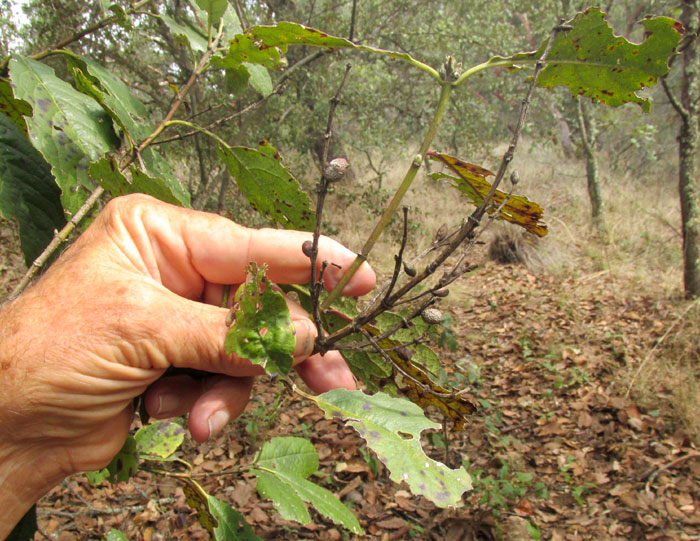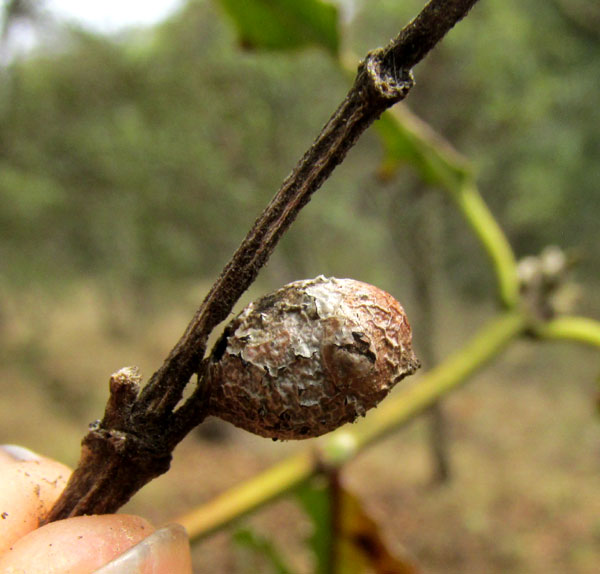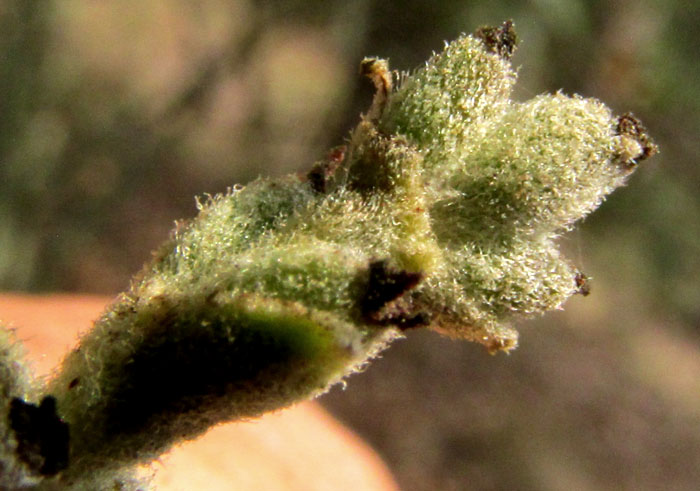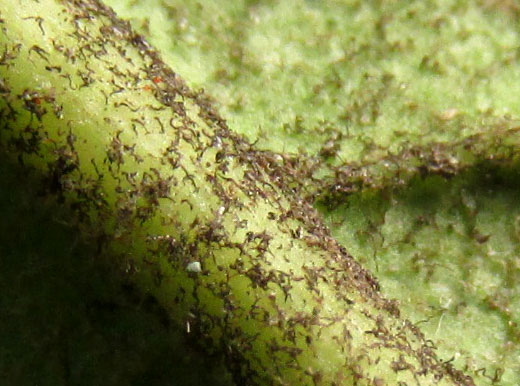Excerpts from Jim Conrad's
Naturalist Newsletter
entry from field notes dated July 2, 2022, taken on the eastern lower slope of Cerro de la Cruz, at an elevation of ~2700m (~8850 ft), just south of the community of El Pinar, Amealco de Bonfil, Querétaro, MÉXICO, (~N20.17°, ~W100.17°)
SILKTASSEL TREE

On the lower eastern slope of Cerro de la Cruz, at the edge of the mountain's oak forest, a small, spindly tree leaned toward sunlight scorching a large abandoned field covered mostly with scattered shrubs and clumpgrass. The little tree was too entangled with neighboring bushes for a good picture of it, but above you can see the only branch on the tree that bore a cluster of last season's dried-up cluster of fruits. Only a few fruits remain, and one is shown close-up below:

The fruit is lopsided with what is apparently the scar left by the broken-off style near the fruit's top. A second fruit must have grown on the rachis's opposite side, but broken off, and another pair of fruits must have developed at the rachis node at the picture's top right. I'd never seen a combination of features like this, so I looked for more clues to the tree's identity, and found what's shown below:

There you see spikes of unisexual female flowers consisting of tiny, oval ovaries, the future fruits, topped with curving black styles. Beneath each ovary there's a sharp-tipped, triangular bract, and everything except the styles is densely covered with short, white hairs. Below, some flowers are seen closer up.

Again I'd never seen such a combination of features. This was something new for me, and more details were looked for.

The leaves, so bug-eaten and spotted with black fungal infection that they obviously remained from the last year's rainy season, were large, somewhat leathery, and their surfaces were wrinkled. They arose opposite one another on stems, and that feature alone precluded a large percentage of plant families the species could belong to.

The leaves' lower surfaces were sparsely covered with dark, short, slender, hairs, some of which looked like they were branched. That was another good field mark.

Above, two opposite petioles arise at a stem tip, with buds arising in their axils. The buds bear no scales like buds on most trees where hard winters occur, plus there's no sign of little ear-like stipules at the petiole bases. Finally, here's what the tree's lichen-covered trunk looked like rising from a thick carpet of oak leaves:

After noticing all these details, I still had no notion of which plant family this tree belonged to. Currently, about 416 families of flowering plants are recognized. Back in the 1970s when I worked at the Missouri Botanical Garden, we recognized 219, so during recent years concepts regarding plant families have changed enormously. And never in my whole life had I knowingly seen a plant like this tree. I had to start at the beginning, by going to the online Lucid Key Server's Interactive Key to Neotropical Flowering Plant Families. There I was led to a family I'd heard of but didn't realize it appeared in Mexico: The Garryaceae.
The Garryaceae comprises only two genera containing about 27 species. It occurs in the western US, plus Mexico, Central America and the Caribbean area, with another appearance in eastern Asia. In Mexico we have the genus Garrya, of which in our upland central Mexico region known as the Bajío there are four species. And if you're in the Querétaro part of the Bajío, and you have a Garrya whose leaf undersurfaces bear dark hairs like ours, and the blade tips are rounded or otherwise blunt-pointed, you have GARRYA LAURIFOLIA.
Garrya laurifolia occurs in forests of oak and pine in mountains throughout most of Mexico, south to Costa Rica, at elevations of 1000-2600m (3200-8600ft). In English, species in the Garryaceae generally are called silktassels. The silken tassels occur on male trees as long, showy, dangling, ament-type inflorescences covered with mutually entangling hairs (the silk). The ament/tasel construction encourages wind pollination.
Why are the Silktassel Family's few species segregated into their own little family? Beyond the details mentioned above as unusual combinations of features, it appears it's because of the plants' unusual chemical profile, and because genetic analysis says they're different from everything else. There's even a Silktassel order, the Garryales, including only two families and three genera, though plant orders normally are much larger.
Among the Silktassel Family's most distinctive features to be easily observed are that they're woody plants with evergreen, simple, opposite leaves with no stipules, and individual plants bear either unisexual male or unisexual female flowers -- they're dioecious. Ovaries are inferior. Chemically, a feature uniting the various genera and species in the Silktassel Family is that they contain petroselinic and chlorogenic acid.
Extracts from our tree's stems are toxic, but traditionally they've been used in Mexico against diarrhea. Bark extracts have been reported as used to bring down fevers.
Central Mexico's high-elevation fir forests are much in decline. Our Garrya laurifolia has been observed surviving under stresses causing other species to disappear, and so has been suggested as a candidate for planting in highly disturbed areas. A 1996 study by Dante Arturo Rodriguez-Trejo and others discusses how to collect and treat the seeds for best germination. It's entitled "Análisis de la semilla de Garrya laurifolia Hartw. expecie opción para plantaciones protectoras en el Parque Desierto de los Leones."